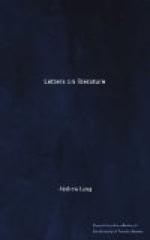“He is rurally related;
Peter Bell hath country cousins,
(He had once a worthy mother),
Bells and Peters by the dozens,
But Peter Bell he hath no brothers,
Not a brother owneth he,
Peter Bell he hath no brother;
His mother had no other son,
No other son e’er called her
‘mother,’
Peter Bell hath brother none.”
As Keats says in a review he wrote for The Examiner, “there is a pestilent humour in the rhymes, and an inveterate cadence in some of the stanzas that must be lamented.” In his review Keats tried to hurt neither side, but his heart was with Reynolds; “it would be just as well to trounce Lord Byron in the same manner.”
People still make an outcry over the trouncing of Keats. It was bludgeonly done, but only part of a game, a kind of horseplay at which most men of letters of the age were playing. Who but regrets that, in his “Life of Keats,” Mr. Colvin should speak as if Sir Walter Scott had, perhaps, a guilty knowledge of the review of Keats in Blackwood! There is but a tittle of published evidence to the truth of a theory in itself utterly detestable, and, to every one who understands the character of Scott, wholly beyond possibility of belief. Even if Lockhart was the reviewer, and if Scott came to know it, was Scott responsible for what Lockhart did in 1819 or 1820, the very time when Mrs. Shelley thought he was defending Shelley in Blackwood (where he had praised her Frankenstein), and when she spoke of Sir Walter as “the only liberal man in the faction”? Unluckily Keats died, and his death was absurdly attributed to a pair of reviews which may have irritated him, and which were coarse, and cruel even for that period of robust reviewing. But Keats knew very well the value of these critiques, and probably resented them not much more than a football player resents being “hacked” in the course of the game. He was very willing to see Byron and Wordsworth “trounced,” and as ready as Peter Corcoran in his friend’s poem to “take punishment” himself. The character of Keats was plucky, and his estimate of his own genius was perfectly sane. He knew that he was in the thick of a literary “scrimmage,” and he was not the man to flinch or to repine at the consequences.
APPENDIX II
Portraits of Virgil and Lucretius.
In the Letter on Virgil some remarks are made on a bust of the poet. It is wholly fanciful. Our only vestiges of a portrait of Virgil are in two MSS.; the better of the two is in the Vatican. The design represents a youth, with dark hair and a pleasant face, seated reading. A desk is beside him, and a case for manuscript, in shape like a band-box. (See Visconti, “Icon. Rom.” i. 179, plate 13.) Martial tells us that portraits of Virgil were illuminated on copies of his “AEneid.” The Vatican MS. is of the twelfth century. But every one who has followed the fortunes of books knows that a kind of tradition often preserves the illustrations, which are copied and recopied without material change. (See Mr. Jacobs’s “Fables of Bidpai,” Nutt, 1888.) Thus the Vatican MS. may preserve at least a shadow of Virgil.




